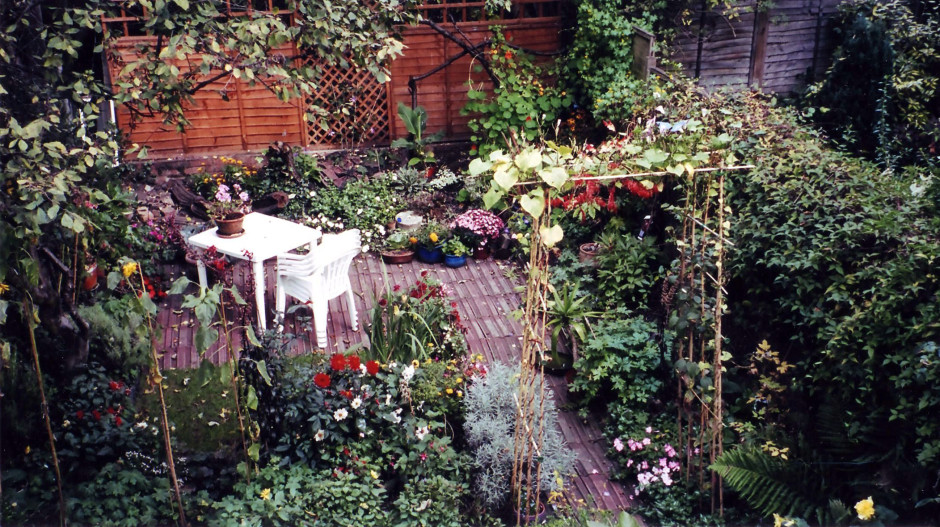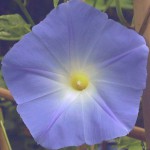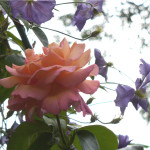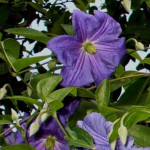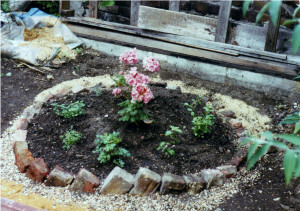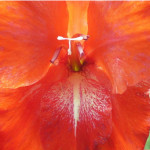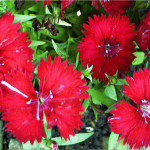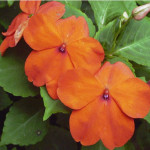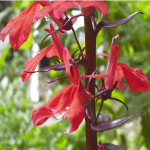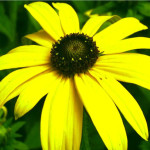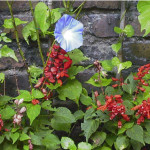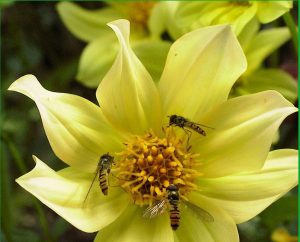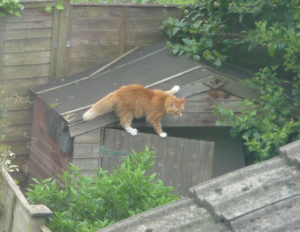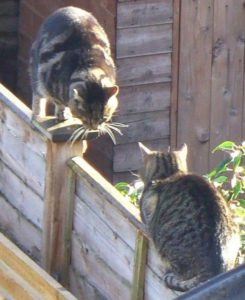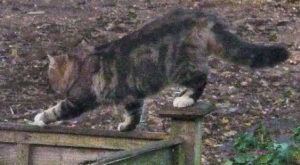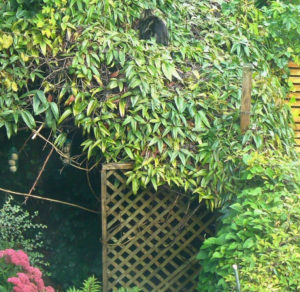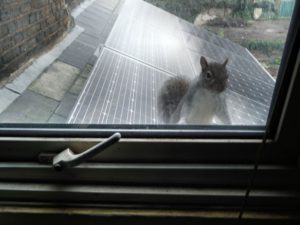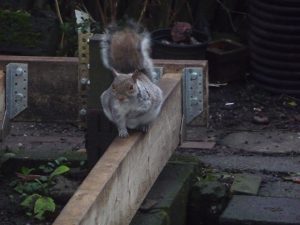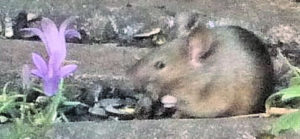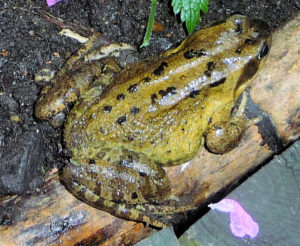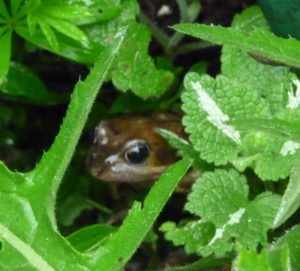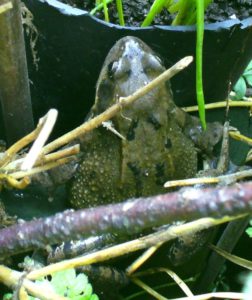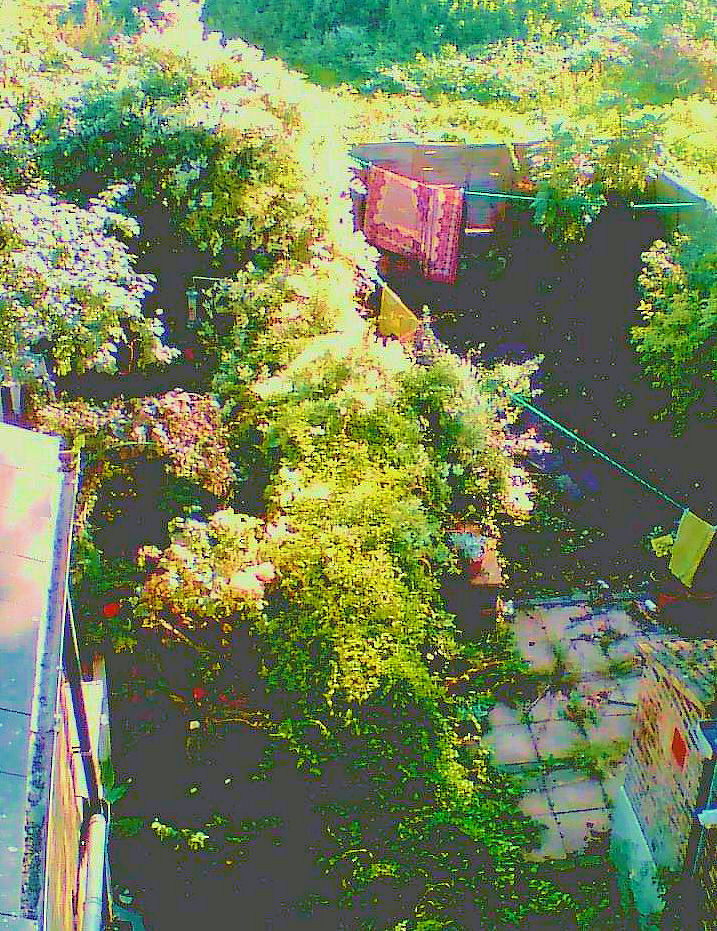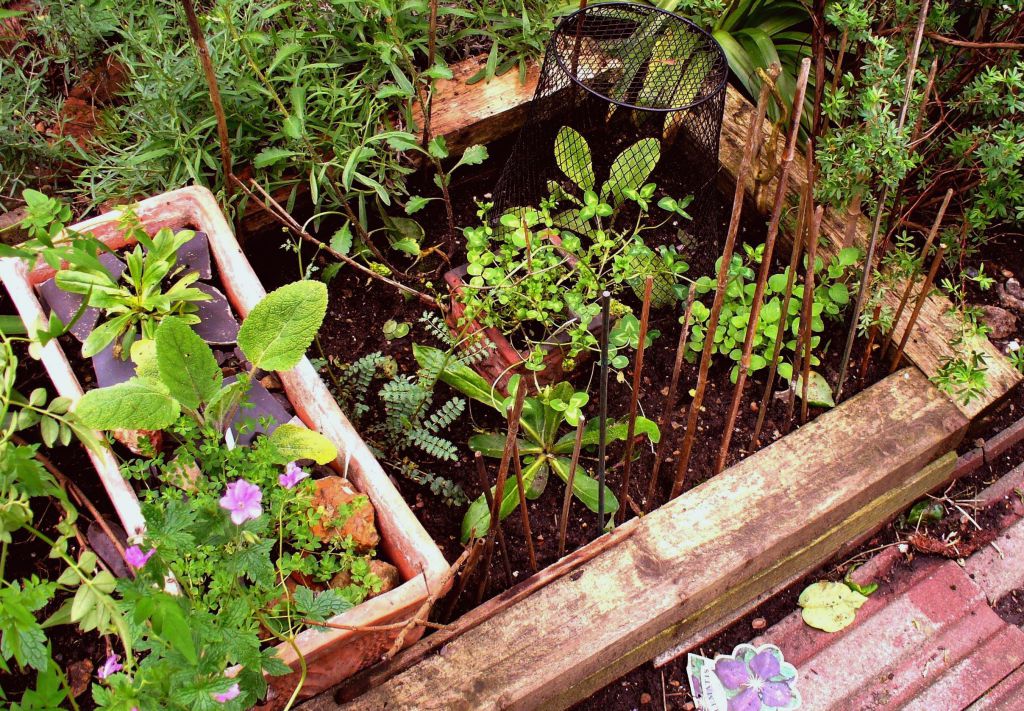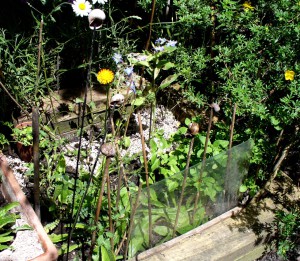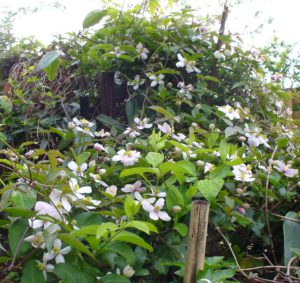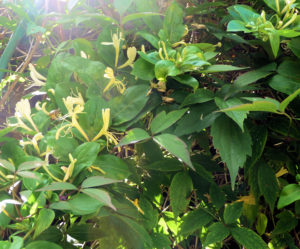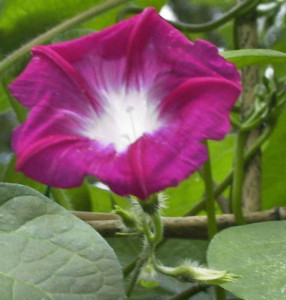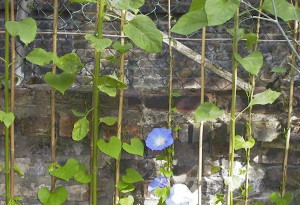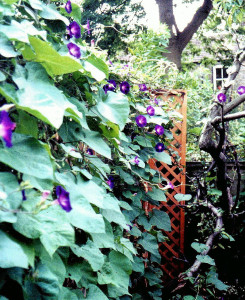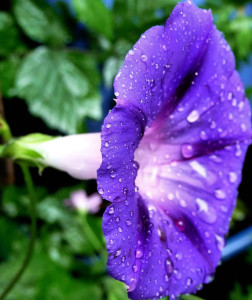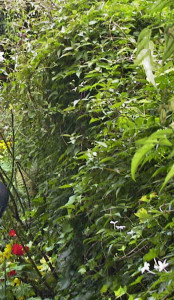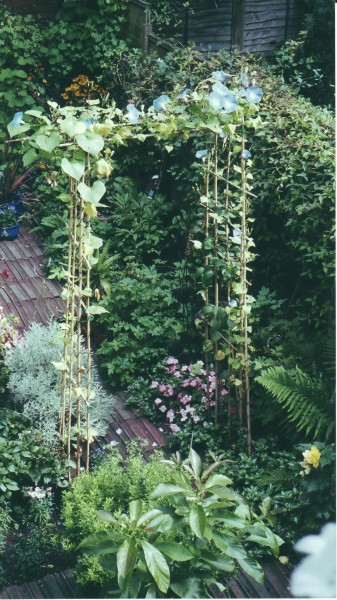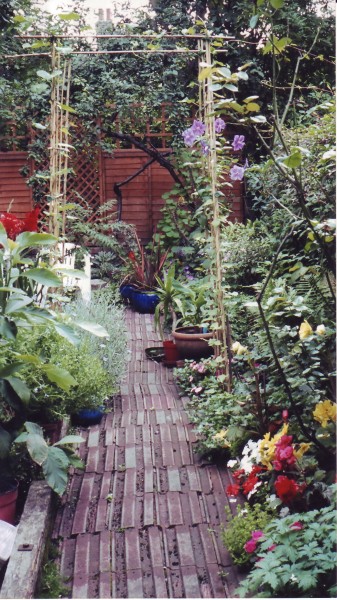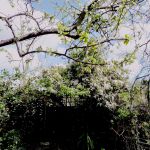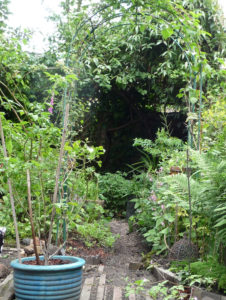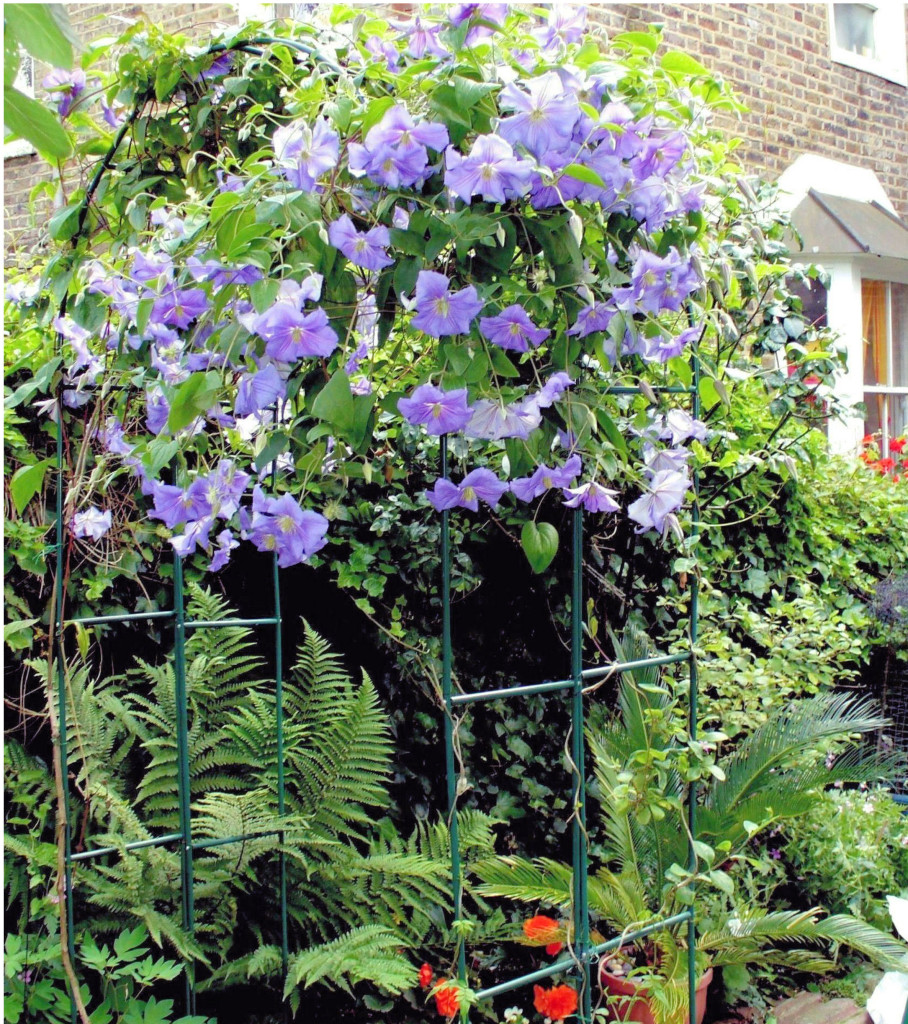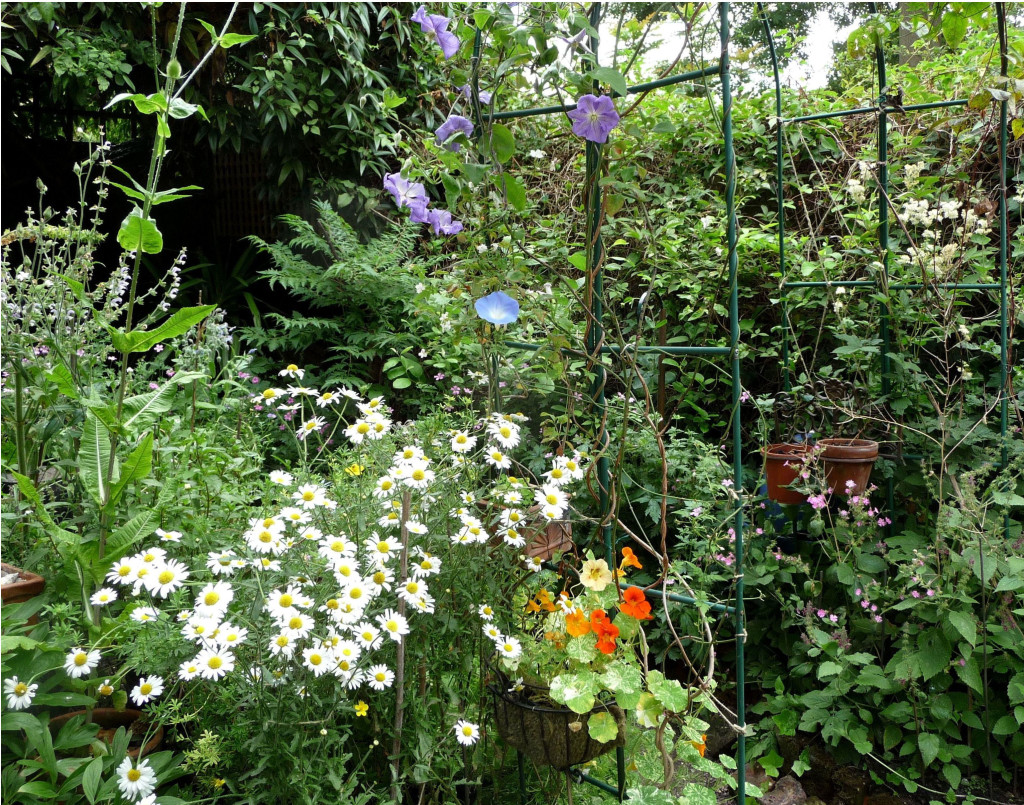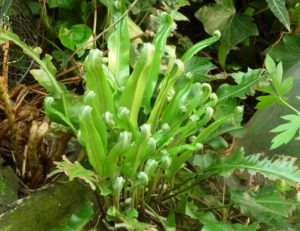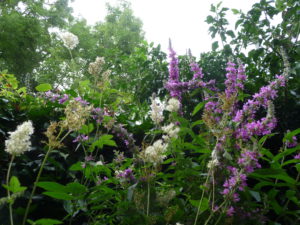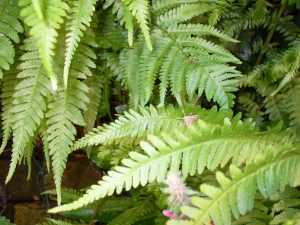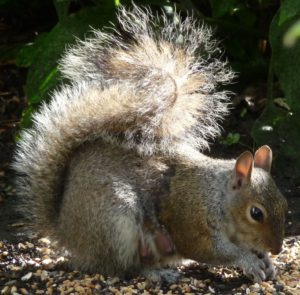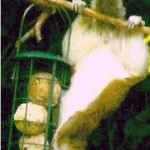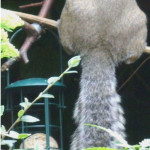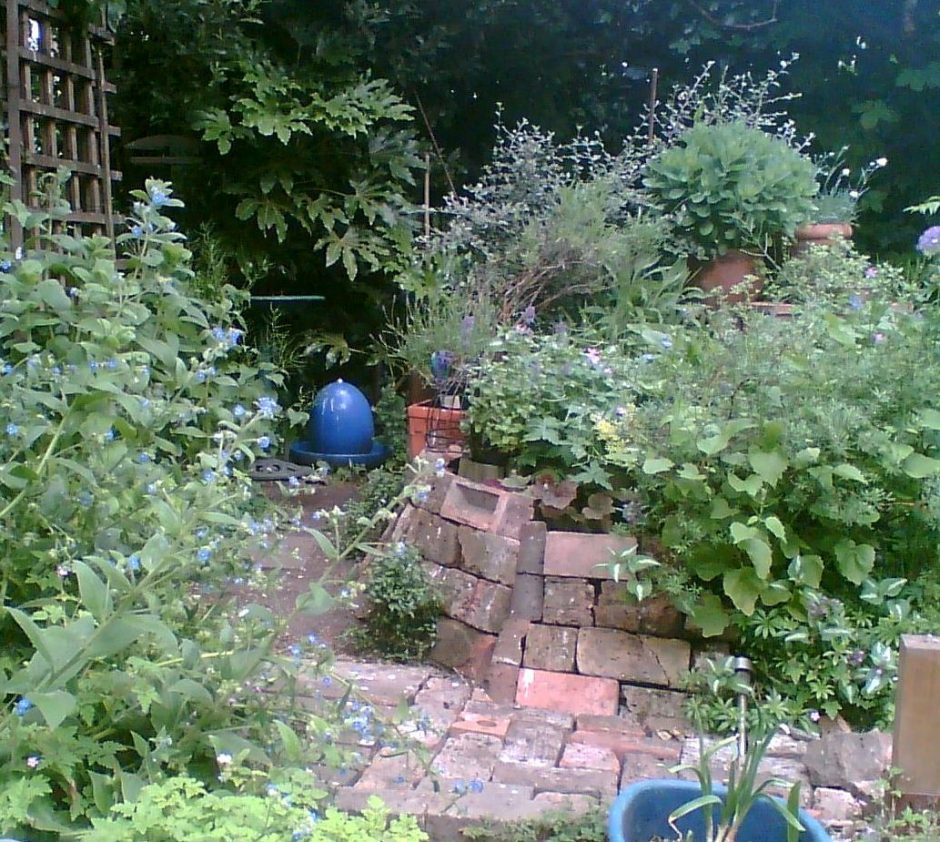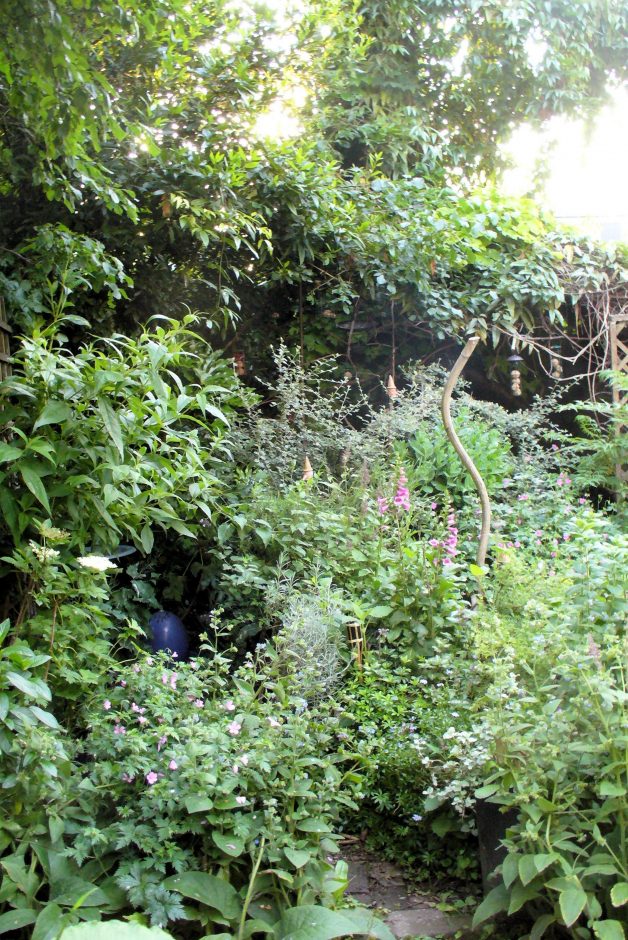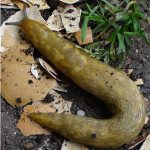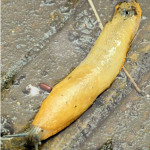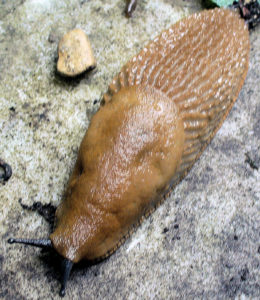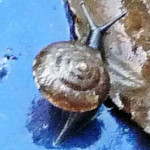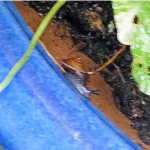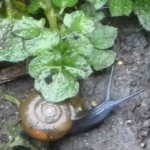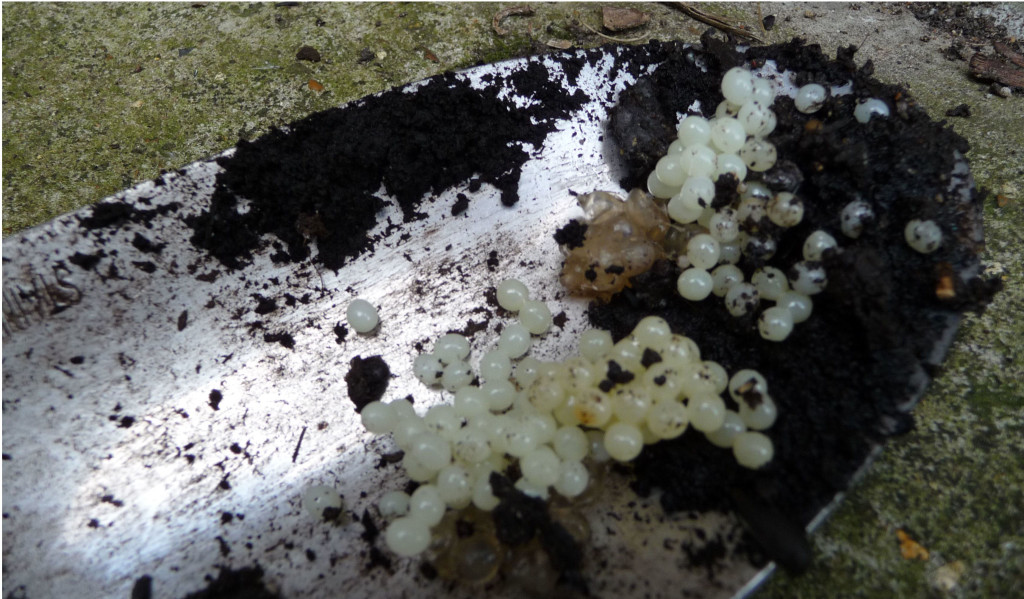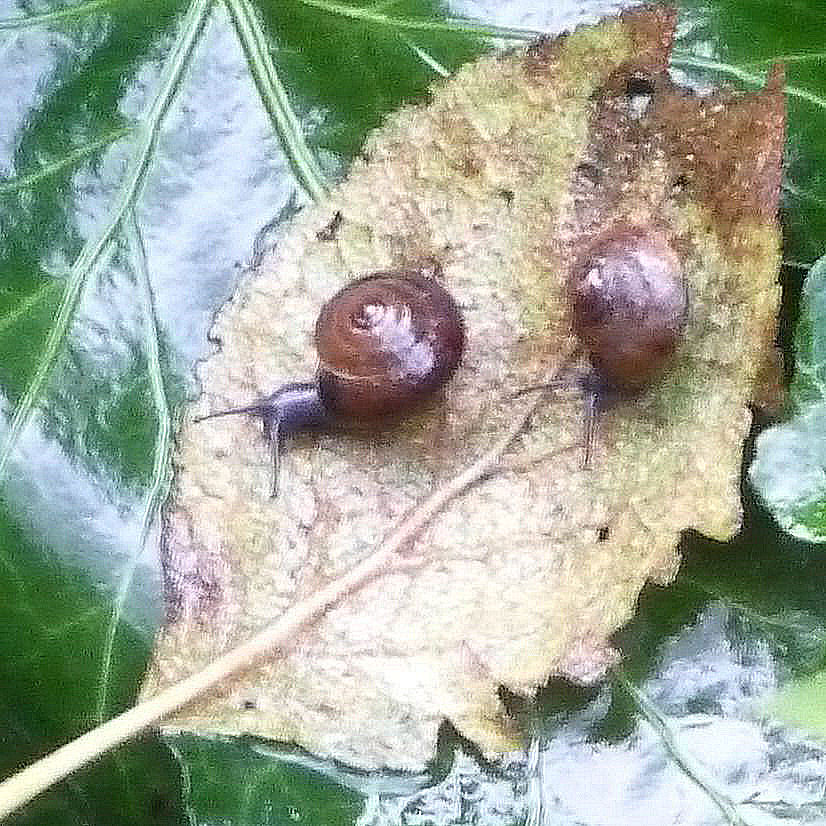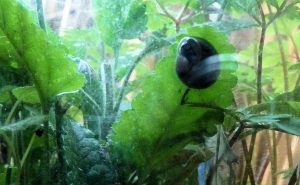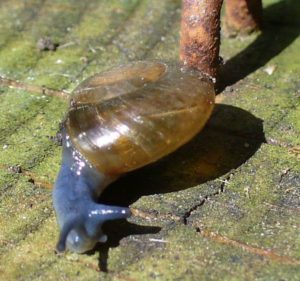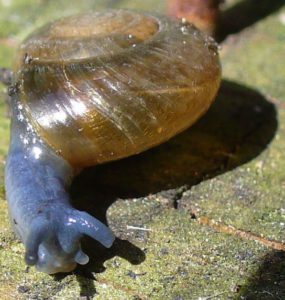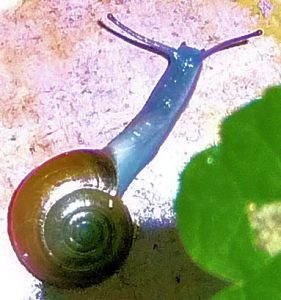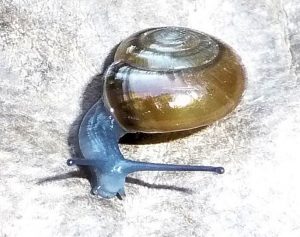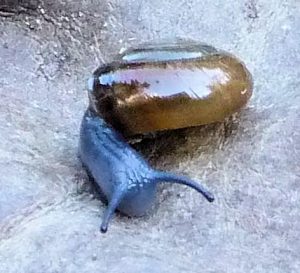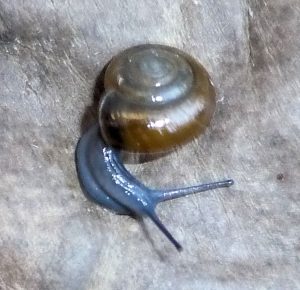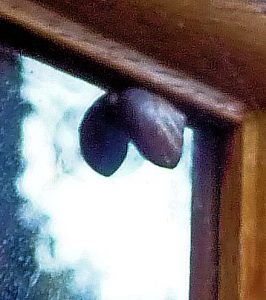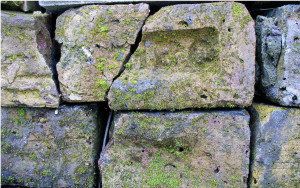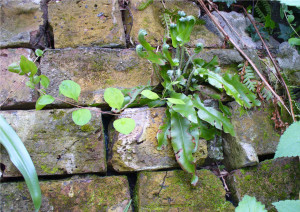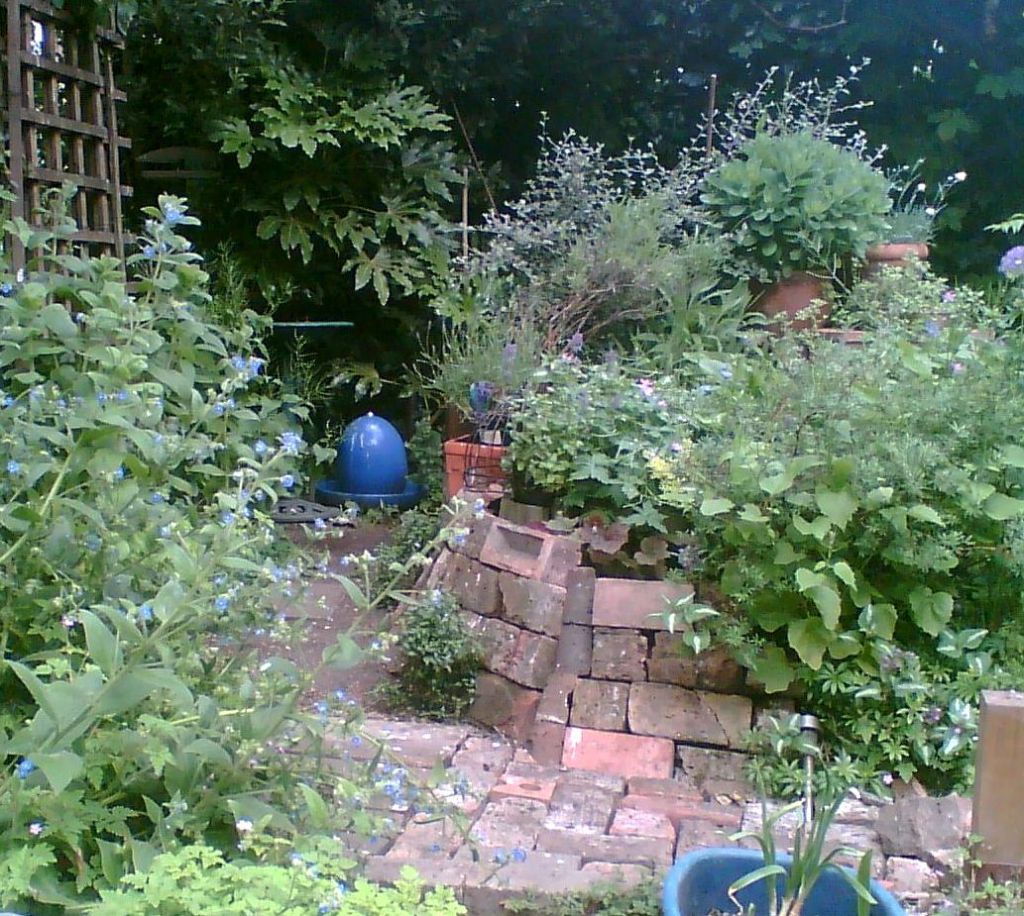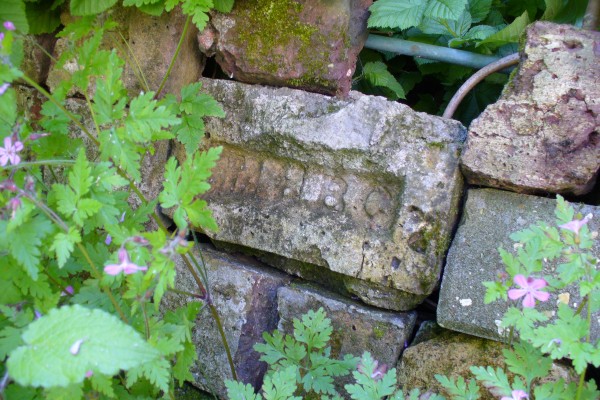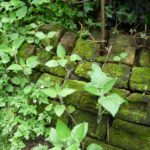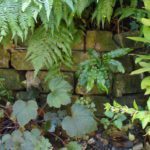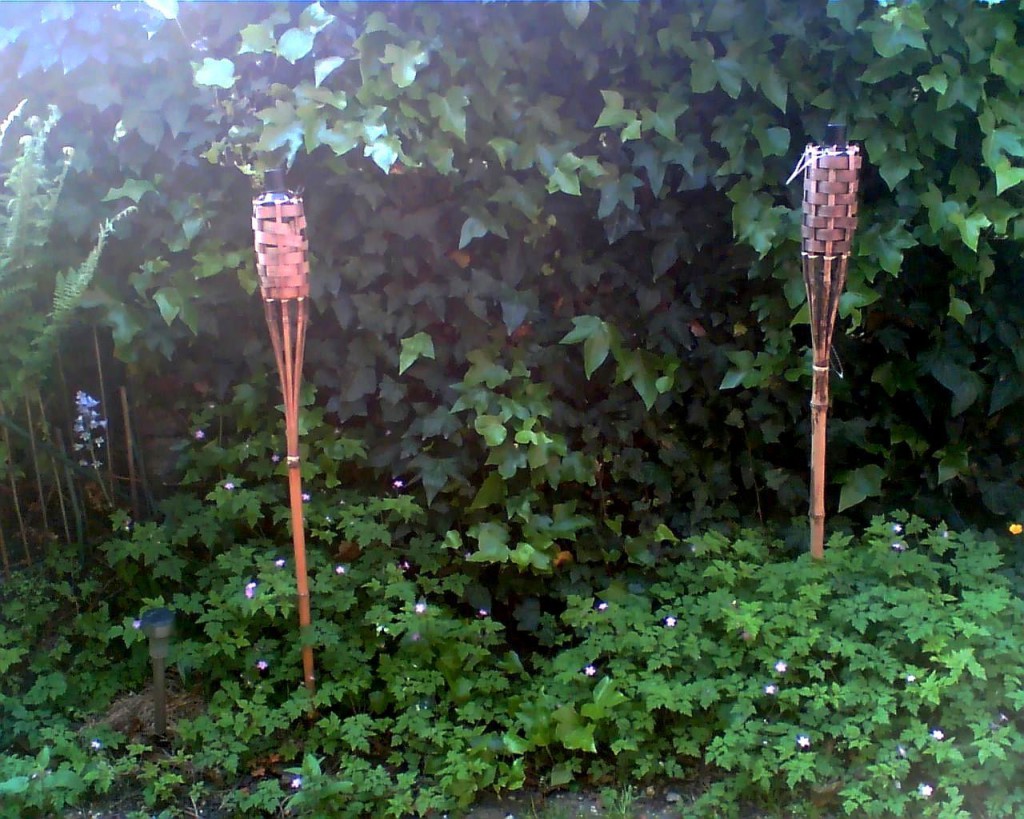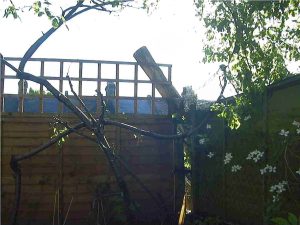
After developers destroyed the little woodland behind our garden, RF and I agreed to try & help the now homeless wildlife that had lived there. We made a log pile in one corner of the garden; climbers ( Ivy, Hops, Clematis & Honeysuckle ) were left to grow wild. We planted wildflowers & chose more wildlife-friendly plants. Any creatures frequenting our garden or what had been the little woodland, would have to adapt to our changes. It would take time.
RF was a plantaholic. He visited Columbia Road flower market on Sundays & always returned with something for the garden. He had learned about gardening from his father, who raised plants in his greenhouse. RF’s garden was neatly laid out, with straight lines & defined flower beds. He was partial to Dahlias, Busy Lizzies, Marigolds, Geum, Hardy Geraniums & Clematis. His garden was alive with colour for most of the year.
RF believed in concentrating on successes, not dwelling on plants that didn’t make it. Winter flower beds were mostly bare earth; in winter he would always say ‘The garden is asleep’.
Cats
The Cats’ meeting place in the little woodland had been trashed by the developers. There was nothing there of interest for them now. Trees, shrubs, paths & wildflowers they had enjoyed were all gone. They still had homes to go to, but for entertainment & socialising, they began to spend more time in our gardens.
Squirrels
After 2003 the Grey Squirrels, whose aerial displays we had loved, were now homeless. Their dreys, high up in the Sycamores, were gone. They came to investigate our houses & gardens.
When a Squirrel got into RF’s attic, the scrabbling overhead kept him awake. He now had Hugh Fearnley-Whittingstall‘s River Cottage Cookbook, with its recipe for Squirrel Pie. We heard him one day, threatening a Squirrel sitting on the fence by his kitchen door: ‘I’m going to bake you into a pie! I have the recipe! I’m not joking!’ The Squirrel sat there unflinching. It never happened.
Find out more about Squirrels on our Living With North London Wildlife page.
Mice
We met with our neighbours before the Public Inquiry into our little woodland. ‘Does anyone know how to get rid of mice without hurting them?’ one asked. ‘You have mice?’ someone asked. ‘We have mice!’ Others joined in. ‘So do we!’ Even in this cat neighbourhood, mice were plentiful. They may have migrated to our properties when the wrecking crew flattened the woodland. Mice now live in our garden as well.
The Living with North London Wildlife page has more about Highbury’s mice.
Slugs & Snails
 RF had long relied on blue snail pellets to keep plants from being devoured by the local molluscs. He agreed to stop using them. This made the garden less toxic to wildlife, but we now had to find another way to deal with slugs & snails. At first we lobbed them over the back fence into the site of the little woodland. But when we found frogs in the garden, slugs & snails took on a whole other identity. We came to look on them as possible food for frogs.
RF had long relied on blue snail pellets to keep plants from being devoured by the local molluscs. He agreed to stop using them. This made the garden less toxic to wildlife, but we now had to find another way to deal with slugs & snails. At first we lobbed them over the back fence into the site of the little woodland. But when we found frogs in the garden, slugs & snails took on a whole other identity. We came to look on them as possible food for frogs.
Frogs
Frogs were silent, hiding in the undergrowth. We were sitting out at dusk, near a pile of old roof tiles destined for the recycle centre, when a wee froggy face emerged from beneath the stack. However long its stay in the garden, it had somehow managed to avoid RF’s blue snail pellets & any snails who had ingested them. We bought a Frog n Toad house & placed a water-filled casserole dish next to it, hoping the frog would make a home there. And it did.
Our Living With London Wildlife page has more to say about frogs.
Gardening Against All Odds
Cats climbed into the garden more often now, battling each other among RF’s plant pots. At night they trashed the herb bed, spraying it with Essence of Cat. Squirrels, cats & woodpigeons walked over plants daily, stunting their growth or finishing them off.
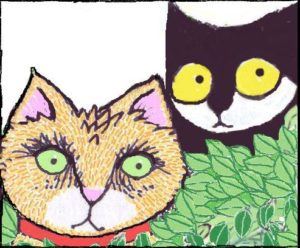 RF’s attempts to grow a tiny lawn, only the size of a beach towel, never succeeded for long… cats treated the area as their personal latrine & squirrels dug into it, burying their prizes. RF was ever hopeful. ‘THIS year I’m trying Canadian grass seed! The hardiest!’
RF’s attempts to grow a tiny lawn, only the size of a beach towel, never succeeded for long… cats treated the area as their personal latrine & squirrels dug into it, burying their prizes. RF was ever hopeful. ‘THIS year I’m trying Canadian grass seed! The hardiest!’
Tidal waves of our neighbour’s Russian Vine swept over their fence every season, swamping RF’s Ivy, Clematis, Honeysuckle & Jasmine.
Hacked back constantly to give other climbers a chance, it became a dense, unruly ‘Hedge’. Wildlife loved it, especially Sparrows & Great Tits. Moths sheltered under the vegetation, & Wrens dived into it, looking for spiders & insects.
Any space on a wall or fence can be enhanced by climbers. We tried a number of them over the years, & eventually found those best suited to this location. But if you’re considering Russian Vine (Mile-a-minnte or Fallopia baldschuanica), beware. Read about its habits before planting it. Gardens are not the ideal place. For true-to-life tales of Russian Vine, see this website:
Wildflower Square
RF said we could have wildflowers in the garden. He chose a sunny spot by the tile path for them. We made a square out of wooden railway sleepers and sprinkled wildflower seeds inside it. And then we waited. Many never sprouted at all, & survivors struggled.
 Then we saw that local cats were also watering the plants, using the square as a scentmarking station.This is an important cat ritual, telling them which of their rivals is out & about. First they sniff, then they turn round & spritz. We had hoped for a small wildflower collection, not a cats’ toilet! A pane of glass was interposed between wildflowers & cats. It solved the problem.
Then we saw that local cats were also watering the plants, using the square as a scentmarking station.This is an important cat ritual, telling them which of their rivals is out & about. First they sniff, then they turn round & spritz. We had hoped for a small wildflower collection, not a cats’ toilet! A pane of glass was interposed between wildflowers & cats. It solved the problem.
RF’s climbers
RF planted climbers all round the garden. Some were perennial, like Ivy, Clematis & Honeysuckle. They left a structure behind them once summer had gone, to cover walls & fences. Some, like the Dark Ipomoea & Morning Glory ‘Heavenly Blue’, were tender & lasted only till first frosts. Each season he planted them again from seed & gave them an early start in his airing cupboard.
The Cane Pergola
RF brought canes back from the garden centre at Alexandra Palace & built the cane pergola, which straddled the tile path. It gave his blue climbers, Morning Glory ‘Heavenly Blue’ and Clematis ‘Perle d’Azur’, plenty of sunshine.
Hoverflies staked out territory at eye level under the pergola, darting out of the way at the last second as you walked through. Once you had gone, they nipped straight back to their positions.
Squirrels sprang from the hedge onto the top of the pergola & rested there. Bees buzzed slowly from one blue bloom to another.
One day a side branch of the old Damson tree, heavy with plums, collapsed onto the Cane Pergola. We recruited friends to help with the recovery. After plums were removed & small branches trimmed away, the still attached fallen branch was tied back.
But the Pergola was never the same again. It blew down time & again in high winds.
The Rose Arch
Over the years, repeated spritzes of cat spray on the lower segments rusted the metal at the joins. The weakened arch finally gave way, buckling in strong winds and blowing over under the weight of its climbers.
RF left for nearby Highbury Fields in late 2008. His plants, except for the climbers, were repotted & taken to his new flat. But some of each pollinator-attracting flower was left for this garden & the wildlife that had come to depend on it.
Making the Garden More Wildlife Friendly
Where possible, everything in the garden is reused or recycled, & has been adapted to how wildlife uses the space. The rooftiles on the path were a rich, rosy colour, but unsafe to walk on. Most went to the Islington Recycle Centre, but some now lie under the suet feeders. They are moved about, exposing slugs that gather under the raised bits, providing protein for Blackbirds, Robins, Starlings & others.
Goodbye to RF’s Cricket Bat
A few sacks of rubbish were left behind after RF’s move… while being carried to the bins one trashday, his old cricket bat fell out. He had made a very good score with it when still a schoolboy. Somewhere along the way it had contracted woodworm, & he had parked it outside his back door. Hard weather had loosened the tape, letting the handle separate from the bat… but both bits leaned there side by side against the house, listening to Test Match Special with RF on warm summer days when he left his door open.
Now, rather than be condemned to landfill, bat & handle were taken out of the binliner & laid in the log pile for a quiet end in RF’s garden. Sic transit gloria.
 WORMS were everywhere in the garden. Earth under the tile walk was the same heavy clay that RF had dug out of the flower beds & heaped by the back fence to make the bank. New compost for the flower beds had been carried back a bag at a time from a shop on Blackstock Road. This compost, from Glastonbury in Wiltshire, is dark & crumbly.
WORMS were everywhere in the garden. Earth under the tile walk was the same heavy clay that RF had dug out of the flower beds & heaped by the back fence to make the bank. New compost for the flower beds had been carried back a bag at a time from a shop on Blackstock Road. This compost, from Glastonbury in Wiltshire, is dark & crumbly.
Worms appearing in the sacred Glastonbury soil were energetic & dark red; those found in the clay looked pale, bloated & exhausted. A spring mulch of cocoa shell was spread over much of the garden; it held in the moisture & was fragrant for weeks, especially in sunshine.
The Fern Bed
On the shady north side of the garden a depression was made in the old flowerbed. It was covered with a sheet of tough plastic poked with a few holes. Earth was sprinkled over the lot & a small wall of old Victorian bricks made for it. Water from rain or garden hose lingers in the depression, making soggy ground.
Leaves, ferns & wildflowers are piled onto the fern bed floor. Besides Male Fern, Hart’s Tongue Fern & native Ivy, Meadowsweet & Purple Loosestrife grow here. Their flowers, much loved by bees, bloom high up on tough stalks.
Cats
Our garden was part of the local cats’ territory, open to the little woodland via our unfenced Northeastern corner. The fern bed was used as a cat latrine – they sprayed into Wildlife Square, trashed herbs in the herb bed & knocked RF’s plantpots over in their battles.
Squirrels
Christine, Ecology Centre volunteer, said that squirrels got into their catflap & raided the fruitbowl. Cheeky. She uses chili powder & chickenwire as squirrel deterrents.
Funny squirrels may be stars on the internet, but they can do damage to a garden or windowsill. Squirrel chases can knock over containers and cause breakages… birdfeeders may be flung to the ground or dragged away. By eating a tree’s bark all round its trunk (bark stripping), they can kill the tree. A squirrel can take offense (as I found after shouting at one), gnaw off a bit of tree branch & aim it at your head. They are fearless, squirrels.
Flowers the size of dinner plates
My friend Ann moved from Islington to Cambridge, where her small back garden had the remains of a greenhouse. Ann was keen on gardening; Vita Sackville-West’s Sissinghurst was a favourite, especially the climbers. ‘All that winding and twining!’ She had firm views on apples… Russets were the best (‘Oooo, nutty!’), Golden Delicious the worst (‘Soggy! Dreadful!’) And she was outspoken on Flowers the Size of Dinner Plates. They were an outrage! When would the growers stop? When flowers were the size of dustbin lids? ‘Oooo!’
Ann’s words came back to me years later, here in Highbury. For years the tile path had been edged with pink, & I hoped to add other colours. Something brighter by the back fence, 50 feet from the house. Why not the strong reds & deep blues of flowers the size of dinner plates?
The Path of Doom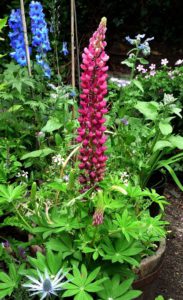
Flowers the size of cricket balls have survived. In Beryl & David’s Watford garden, bees were all over their Oriental Poppies. I tried growing them here, in the half barrel. They flowered & brought in the bees. Until slugs got to them.
One of the Lupins we tried was called ‘Lucy’. She looked like a small red Christmas tree, seen from the house. Bumblebees loved Lucy. So did slugs & snails. A ‘Path of Doom’ evolved round one side of the half barrel… whatever grew there, including Lucy, was slug & snail fodder. So she was dug up, repotted, & brought indoors night after night. Richard from the Ecology Centre suggested a small moat of water round the next pot of Lupins… If you do not use chemicals, you must be creative.
Wildlife garden evolving in Central London
Slugs & Snails

Blue Glass Snails
These little blue snails live in the flower beds beside our old brick walls. They leave no slime trail. While the Garden Snail is often at the scene of its crime devouring a plant, these mini snails are seldom noticed. Adults are the size of a cat biscuit.
We now know they are Glass Snails – Oxychilus. There are four UK branches of the family – the Cellar Snail (Oxychilus cellari), the Garlic Snail (Oxychilus alliaria), the Glossy Snail (Oxychilus helveticus navarricus) & Draparnaud’s Glass Snail.
Most of our tiny blue snails have waxy shells & long slim tentacles. They are Draparnaud’s Glass Snail, the carnivorous Oxychilus draparnaudi. Plentiful in the UK southeast & Western Europe, they eat small slugs, snails & the eggs of the Large Red Slug Arion rufus (above, left [grooved & red, blobby & orange].
Given a choice of what to eat, the Blue Glass Snail has preferences. If no slugs or snails are on offer, only vegetation, it will eat that. A snail can live for up to two years in damp, humid conditions under leaves & stones, feeding on young slugs, snails, worms – & cat & dog food.
Other molluscs like cat & dog food. When our garden cat Tiggy was alive, we kept a bowl of cat crunchies in the garden flat kitchen for him. Large Red Slugs would occasionally be found in the bowl, munching his biscuits. [In her Notting Hill Gate garden flat, Ninon says her cat’s bowl of dry biscuits is also invaded, by a green version of The Large Red Slug].
Natural Enemies of Territorial Molluscs, ed. G.M. Barker CABI Publishing, Oxfordshire, UK.
http://www.gardensafari.net/english/snails.htm
In the two photos (right), Oxychilus Draparnaudi is being pursued. Was this bullying, or was it The Garden Snail seeking revenge, i.e. ‘You ate my brothers!’
Our tenants’ association looked into the history of the woodland behind our houses – it had been market gardens before the war. Our own garden had had a greenhouse, but no back wall – it would have opened onto the market gardens. Could these Blue Glass Snails be descended from Guard Snails relied on by local market gardeners to save their veg & ornamentals from the local molluscs?
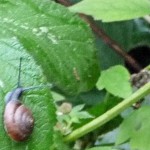
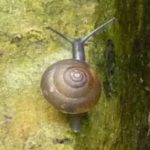
 While planting up new raised beds in her tiny Wimbledon garden, Anne, a designer with a soft spot for snails, said she couldn’t bring herself to get rid of all of them… “Because they are so beautiful.”
While planting up new raised beds in her tiny Wimbledon garden, Anne, a designer with a soft spot for snails, said she couldn’t bring herself to get rid of all of them… “Because they are so beautiful.”
Snails in Anne’s garden are Garden Snails (Cornu Aspersum). If their beauty can help her to forgive the damage that they do, the elegant Draparnaud’s Glass Snail must surely win her over. Its cobalt blue body & waxy cocoa shell with pink dot at the tip are beautifully designed. I’ve offered to donate a few Highbury Glass Snails to Anne’s Wimbledon garden, as neighbours used to donate frogspawn to each other’s ponds…
The blue snail pictured here was found on the south side of the garden. With its stubby tentacles and a shell that looks like a glazed pastry, it must be the Glossy Glass Snail (Oxychilus helveticus navarricus).
5th October 2021
This snail was found crawling up the brickwork outside the back door of the house. Much rain had fallen in the week. Placed in a gloved hand to be photographed, then left on a bit of terracotta in a container w/ Hedge Woundwort & Elder – could it be the Oxychilus Glossy Snail? The tentacles are not stubby, but long… A photo, above, from 2020, taken from inside the bay window, shows two wintering snails clinging to the glass, behind a terracotta trough of Betony. This could be one of them.
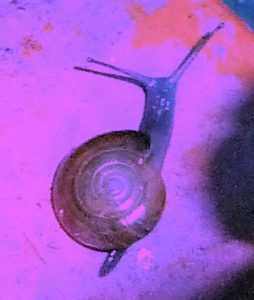
Oxychilus – Glossy Glass Snail on bit of broken terracotta. See the little breathing holes? on its back. Difficult showing true colours. The shell is the same colour as in above photos, but the snail’s blue body is a deeper blue than shown here.
The Dry Brick Wall Around the Earthwork
The Earthwork in the centre of the garden began as an eggshaped island bed outlined in old bricks. Other bricks were unearthed in the garden dig – old, weathered, some broken, in many colours & sizes, some bearing scorch marks from the kiln. They were stacked on edge, in low ‘dry brick’ walls, tilting in at the top like Cornish hedges. Inspiration was from Camley Street Natural Park by the Regents Canal. Years ago I saw a wall there, made of old brick & stone, loosely put together. Its crevices gave shelter to small creatures & left places for wildflowers to grow.
The weathered Victorian bricks seem to have been made locally; see Victorian Highbury – London Clay and the Brickfields to find out more about old bricks.
Another small wall of old bricks was made to enclose the fern bed. There is less sun on these bricks and they have developed a coating of moss that goes well with their plants – Herb Robert, Purple Loosestrife, Meadowsweet, Ferns.
The Ivy Wall
RF planted ivy on the north and south borders. This has provided a green background for other climbers and perennials. We trim it to shape, only enough to keep it close to the walls. New tendrils are woven back into the older stems, to bulk up its mass & make it more hedgelike. Next-door neighbours keep it trim on their side, & we stash fallen leaves under it. Birds and frogs forage through this leaf litter, finding small creatures to eat. (See Bees Favourites, the English Ivy page for more about this wildlife-friendly climber.)
VIDEO – GARDEN LOOKING GOOD, MANY BIRDS AT BREAKFAST
